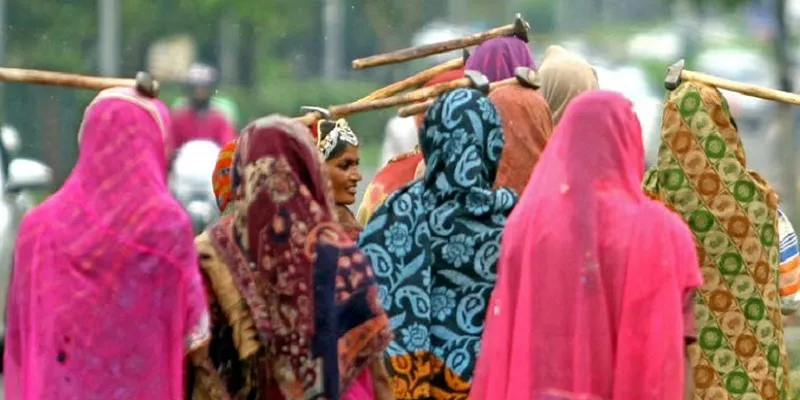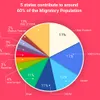It’s time for ‘Her Gig’ at the economy
From ‘Beti Padhao’ to ‘Beti Kamaon,’ India’s gig economy offers a huge untapped potential that can raise a rural woman’s standard of living thanks to the digital ecosystem. It is time that rural women increase their opportunities, and embellish their lives.
Searching for a new apartment? Discovering new cafes around you? Or trying to find a carpenter in your area? Chances are, you picked up your smartphone to use an application that figures everything out. That application, like many others, relies primarily on the workforce of the gig economy.
As per the Oxford dictionary, gig economy is, “a labour market characterised by the prevalence of short-term contracts or freelance work as opposed to permanent jobs.”

Image credit: The Indian Express
A growing gig or platform economy is the by-product of the ongoing digitisation in almost every aspect of life. Doing so has opened a whole gamut of possibilities in the workforce. Barriers which could have prevented people from finding work are diminishing. A driver needn’t wait all day long for someone to walk up to him for the next ride, he can find the closest passenger. A baker needn’t have a store for people to buy their cakes or breads. A mother who needs flexible timing doesn’t have to wait for a 9 to 5 job to start earning a livelihood. In fact, gig economy could well be the future of work and workforce.
The harsh truth
A recent report by the Ministry of Electronics and Information Technology, in partnership with McKinsey, stated that India can create over $1 trillion in economic value from the digital economy in 2025. It further revealed that half the opportunities will originate in new digital ecosystems that can spring up in diverse sectors. However, this huge potential cannot be exploited to the fullest if the yawning gender gap in the Indian workforce persists. Female participation in the workforce in India has fallen from 36.7 percent in 2005 to only 26 percent in 2018. If we are to achieve the best in class economic gender parity, that itself could add over $700 billion to India’s GDP, which is a staggering 27 percent increase. Imagine where that could take us?
Traditionally, female participation in the workforce has been low in India and elsewhere in the world, primarily owing to patriarchal social norms which predefine the role of a woman in the society. That also leads to a lack of focus on education and upskilling for women, limiting their choices even if they want to work. While we see a lot of women participating in the labour force in rural India, it is mostly in the agricultural and unorganised sector with little pay, and an unsafe environment.
But just as technology has brought about dramatic changes in our lifestyles, it could be the game changer for these women as well. A lot of the limitations for these women stem from issues around not being able to travel too far from their houses, lack of quality education or any education at all, the need for higher flexibility to manage their household work and the cultural mindsets around what is respectable and acceptable.
As I travelled across the country to meet women who had discovered the internet, I saw how they had used the access to information to overcome these limitations. They upskilled themselves and the internet became the alternative to the education they had never received. They found ways to access raw materials to create products without having to leave their familiar surroundings. They found buyers within their communities just by sharing pictures through social media or chat apps. They found livelihood opportunities without having to commit to a 9 to 5, five-days-a-week job.
Small steps in the rural landscape
Savita from Balrampur in Uttar Pradesh took up the opportunity of campaigning for prevention of child marriage under the UNICEF Smart Betiyan campaign. Savita creates videos capturing stories of families who have gone against child marriage, uploads it onto the cloud and receives final edited versions of the stories. In her free time, she shares these videos among her community for the campaign. As a mother of a one-year old, she claims that the best part about this opportunity is that it doesn’t bind her down to a fixed schedule. Now, she is able to work, take care of her child and also earn an income for herself.
There are women like Minakshi from Jategaon village in Maharashtra, who have discovered means of making goods and selling them without having to run a store. While surfing the internet, Minakshi discovered how cloth can be recycled to make quilts. She made her first few quilts with discarded cloth in her house, and now gets other women to give all their old clothes and makes quilts for them at a cost. She uses the internet to promote her products, and source new orders. By doing this in her free time, Minakshi who is a teacher, is able to make an additional Rs 20,000 a month and is using this income to complete her B.Ed.
The Internet Saathi impact study done by Kantar in 2018, showed that 20 percent of the women who benefited through the digital literacy work of the programme had claimed that they had started some form of business, and were earning an additional Rs 4,000 per month as a result of the information and opportunities they discovered on the internet. Given that the average household income in these villages is around Rs 8,000, this additional income has been a major boost to their families.
There are thousands, maybe millions of women who have earned their first income by selling food items, clothes, handicrafts, beauty services, new forms of spices and so much more because the physical world barriers have been overcome by the digital world. They don’t need a store, they don’t need to travel and given the absence of fixed costs, they can work basis timelines which are comfortable for them.
I am a firm believer that technology can play an instrumental role in consolidating the remote and mobile rural women workforce in a new and growing gig economy. Just like the newest set of internet users skipped the desktop phase altogether and went straight to mobile devices, we are likely to see similar patterns with the next set of internet users from rural India where they skip phases of evolution and go directly to become active participants of digital marketplaces, digital payments and online education, etc.
A report by Boston Consulting Group says that by 2020 half of the internet users will be from rural India, out of which 40 percent will be women. The rise of gig economy coupled with increasing internet penetration amongst women can be a game changer in the Indian economy. With the proliferation of the internet, there are opportunities emerging which are either new or more accessible now than before. All that is required is to connect the capabilities with the opportunities.
If there was ever a time to get the women a gig in the economy, it is now!
(Disclaimer: The views and opinions expressed in this article are those of the author and do not necessarily reflect the views of YourStory.)
(Edited by Suruchi Kapur- Gomes)







